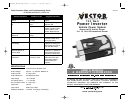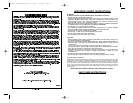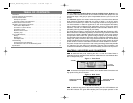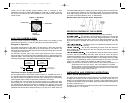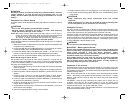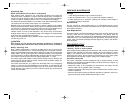
7
CARE AND MAINTENANCE
Storage
1. Ideal storage temperature range is 50-68°F (10-20°C).
2. Store and use the inverter in a cool, dry place with adequate ventilation.
3. Avoid locations that are exposed to heating units, radiators, direct sunlight or
excessive humidity or dampness.
Maintenance
This unit contains no user-serviceable parts. It is recommended that the unit be
returned to manufacturer for service (see the Warranty for repair/replacement policy
and contact information).
Fuse Replacement
This power inverter is equipped with multiple internal fuses. Normally, these fuses will
not blow unless there is a serious problem inside the unit. Internal fuses are
replaceable, however, only electronically knowledgeable people should attempt fuse
replacement. If the unit is damaged during fuse replacement, the warranty may be
voided. Vector recommends contacting Technical Support for guidance. Call toll free:
(866) 584-5504.
TROUBLESHOOTING
Common Audio/Visual Problems
“Buzzing” sound in audio systems
Some inexpensive stereo systems and “boom boxes” emit a buzzing sound from their
speakers when operated from the Power Inverter. This occurs because the power
supply in the electronic device does not adequately filter the modified sine wave
produced by the inverter. The only solution to this problem is to use a higher quality
sound system that incorporates a higher quality power amplified supply.
Television Interference
The Inverter is shielded to minimize interference with TV signals. However, in some
instances, some interference may still be visible, particularly with weak TV signals. Try
the following corrective measures:
• Position the inverter as far as possible from the television, the antenna and the
antenna cables. Use an extension cable, if necessary.
• Adjust the orientation of the inverter, the antenna cables and the TV power cord to
minimize interference.
• Make sure the antenna feeding the television provides an adequate (“snow free”)
signal and that high quality, shielded antenna cable is used.
6
Operating Tips
Rated Versus Actual Current Draw of Equipment
Most electrical tools, appliances and audio/video equipment have labels that
indicate the power consumption in amps or watts. Be sure the power consumption of
the item you wish to operate is rated at 750 watts or less. (If the power consumption
is rated in amps AC, multiply by the AC volts (115) to determine the wattage).
The inverter has overload protection, so it is safe to try to operate equipment rated at
750 watts or less. The inverter will shut down if it is overloaded.
Resistive loads are the easiest for the inverter to operate. However, large resistive
loads, such as electric stoves or heaters usually require more wattage than this inverter
can deliver on a continuous basis. Inductive loads, such as TVs and stereos require
more current to operate than do resistive loads of the same wattage rating.
Induction motors, as well as some televisions, may require two to six times their
wattage rating to start up. The most demanding in this category are those that start
under load, such as compressors and pumps.
Testing is the only definitive way to determine whether a specific load can be started
and how long it can run.
CAUTION
This inverter will not operate high wattage appliances or equipment
that produces heat, such as hair dryers, microwave items, or toasters.
Battery Operating Time
With a typical vehicle battery, a minimum operating time of 2 to 3 hours can be
expected. In most instances, 5 to 10 hours of operating time is achievable. However,
Vector recommends that the operator start the vehicle every half hour to recharge the
battery system. This will guard against any unexpected shut-down of the equipment
and will ensure there is always sufficient battery capacity to start the vehicle’s engine.
The inverter will sound its alarm when DC voltage drops below 11.0 volts.
The inverter may be used whether or not the vehicle’s engine is running. However, the
inverter may not operate while the engine is starting since the battery voltage can
drop substantially during cranking.
The inverter draws less than 0.7 ampere from the battery when it is not supplying
power to a load and ON/OFF Pushbutton is in ON position. In most instances, the
inverter can be left connected to the battery when not in use since it draws so little
current. However, if the vehicle is to remain unused for several days, disconnect the
inverter from the battery.
VEC1043_ManualEN_091505 1/17/06 5:49 PM Page 6



